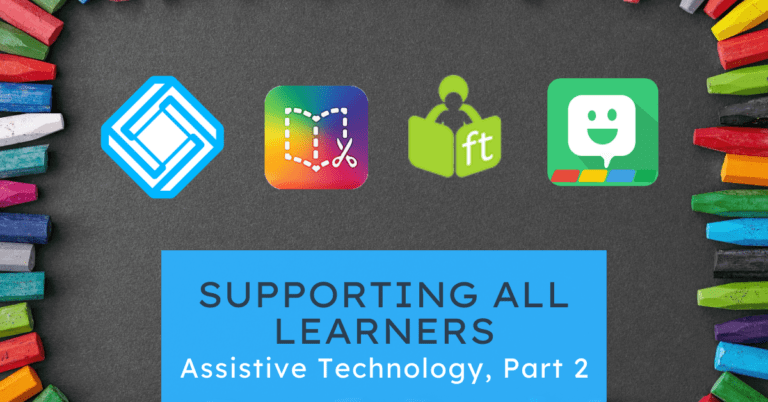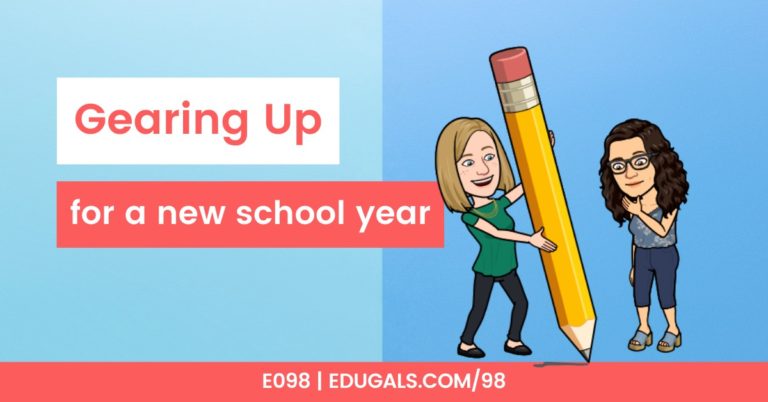In this episode, we are revisiting destreaming and how it is going in our classrooms. We will share some of our progress, what we are changing in our classrooms, as well as some resources to help guide you along the way.
If you like what you hear, we would love it if you could share this episode with a colleague or friend. And make sure you subscribe so that you don’t miss out on any new content! And consider supporting the show by buying us a coffee or two!
We would love to hear from you – leave a comment on our website OR check out our FLIP!
Show Notes
This week, we are chatting a bit about how destreaming is going because we wanted to give an update now that we are well underway this semester and school year.
For those that may not be in Ontario, last year we began destreaming; it started with Grade 9 math. As of this semester, we began with destreamed Grade 9 science, with the remaining subjects all being offered in the academic pathway only.
This is just for grade 9s only. The core of destreamed curriculum really hasn’t changed much at all, however there has been more incorporated into these officially destreamed curriculums, including indigenous perspectives. There still exist high academic standards – just because it is a single pathway, does not mean that the curriculum has been watered down or simplified.
In Rachel’s world of science, destreaming is a bit weird because of the IB programme. Grades 9 and 10 for pre-IB students is still streamed into a separate course. The students that aren’t pre-IB are then fully destreamed.
So far, Rachel has found that the true destreamed classes are actually working through the course material at a quicker pace. That being said, the destreamed classes were intentionally kept at a lower class size since they have a wider range of student needs and learning experiences. The pre-IB courses are closer to 30 students in a class.
The lower class sizes for destreamed science has really allowed for more effective relationship building and interactions with the students.
Teaching strategies in destreamed programming
Rachel and her course team are also doing a self-paced, mastery-based learning format in their classrooms, with aspects of ungrading implemented as well. While there have been a lot of growing pains, it has allowed teachers to try new things and bring in a variety of strategies.
Katie has also noticed that a lot of Grade 9 teachers, whether they are teaching destreamed or academic, are trying new things in their classes, whether it be aspects of design thinking, mastery and/or ungrading. It’s fascinating to see how teachers are making purposeful changes to try to reach all students, especially when it isn’t easy!
Here are some of the teaching strategies that Rachel and her team have been implementing to help support student learning:
- Self-paced structures
- Mastery-based learning (Modern Classrooms Project)
- Ungrading
- Thinking classrooms
- Design thinking
- Visible thinking (Project Zero)
- Indigenous perspectives
All of these strategies combined have led to an exciting start to the new school year. Already, students have done a variety of challenges, such as designing and building catapults.
While not all things may be going smoothly, the more we try new things, the more changes we can make that will help support all students in learning. There is a lot to be optimistic about with respect to destreaming, so a little bit of learning and readjusting is a positive step in the process.
Growing pains with destreaming
Some of the growing pains that Rachel has experienced have been related to mastery-based learning models and having too much content and choice for practice – it has made students feel like they have to do everything. This could be learning pains for the students, just as much as the teachers, however it has made her think a bit more about how to categorize work into those “must do,” “should-do,” and “aspire to do” categories.
Implementing new systems in the classroom is not going to be an overnight project – it will take time for everyone to adjust and figure out how it all works.
Another area that has experienced some growing pains is the introduction of ungrading into the classroom. While the intent is to shift away from traditional grading practices, and mastery rubrics are being used, the labs and design challenges are still created with the thinking of traditional grading. This hasn’t allowed students enough time or opportunities to improve on those skills.
Needless to say, Rachel and her team are really trying to reimagine how to make it work more efficiently and effectively for the future.
Another challenge has been trying to make these new teaching and grading practices fit within traditional reporting periods. Here in Ontario, we provide 5th week reports for all Grade 9 students, and those in Grade 10-11 that are struggling. This doesn’t jive well with ungrading practices and the idea of mastery. The first couple weeks of school are really about getting to know students, building community, and figuring out what students do and do not know. Having to provide a progress report after 5 weeks is a bit of a challenge.
Things that are working for destreaming
There are many things that we like, and that we think are great indicators that destreaming can be done well.
Professional Development
The first thing we both love is that PD (professional development) for destreaming is still ongoing. Teachers are still have to get release time to meet with other teachers in the board, and do some important and meaningful learning about how to more effectively teach destreamed courses.
Schools also have teams of teachers dedicated to destreaming. This allows schools to build capacity in staff, and then have those staff members share their learning and best practices with others.
Our PD day in October had time dedicated to destreaming and working in departments to further the discussions and learning. A wide range of instructional strategies are shared, which is important because no two educators teach in the same way; everyone adds their own personality or preferences to their teaching practice based on the students in front of them.
Collaboration
An additional aspect that is working well for destreaming is the collaboration across the province. On Twitter, lots of educators are sharing resources, such as this onted destreaming website, and PD opportunities with others. It’s a great way to connect people across the province and share best practices.
This has also been present on Facebook. In August, Rachel came across a group that was created specifically for destreamed science. There is so much sharing and collaboration happening!
Reflection
Due to the professional development opportunities, as well as the true collaborative effort to make it work, there has been a lot of opportunities for educators and course teams to reflect on how things are going, and problem solve through some of the challenges.
What is still needed?
While we would love to say that things are perfect and implementation is flawless, there’s always room for improvement, so we thought we would share what we feel is needed to further support destreaming.
Learning about CRRP
Culturally responsive and relevant pedagogy (CRRP) is at the heart of destreaming. In order for it to be effective, all educators need to better understand the role of CRRP and how to implement these practices effectively in the classroom. This needs to be at the heart of everything we do, because without it destreaming will not work.
Difficult conversations
There will always be people that don’t believe in destreaming or the reasons behind it. In order to combat this, we need to engage in these difficult conversations, and continue to talk about the reasons why destreaming is so important. Students need to be able to start high school with open doors and all pathway opportunities – this doesn’t mean that we believe all students should go to university; it means that we believe all students should have the choice as to what they will do after high school. Streaming has taken away this choice in the past, and it has negatively impacted our racialized students in particular. This needs to stop, and destreaming is the way to do this.
We need to have these conversations; we need to name them and keep moving one another forward. Change is hard, but that doesn’t mean it shouldn’t happen.
UDL
Universal design for learning is an important framework that works hand-in-hand with CRRP. It gets teachers to consider the learners in front of them, what their needs are, and how to minimize and address any barriers to learning that exist for students.
Time
We talk about this often – one of the most powerful tools or resources that teachers can be given is time. All educators need time in order to make these important and difficult changes to their teaching practices. Learning new practices, developing new resources and effectively implementing it all takes a LOT of time. In order to do it right, there needs to be support.
Try, fail and learn mindset
The last thing that we need is a shift in our mindsets. We need to be open to imperfection and not getting things on the first try. It’s going to take multiple attempts to find what works best for you and your students, so don’t give up when it doesn’t work the first time!
While the timing was rushed, and destreaming was likely not implemented for the right reasons, educators really are making the most of it and trying to make it work successfully.
We’d love to hear about what you are doing in your Grade 9 classes this year! Have you implemented any new strategies or practices to help make content accessible for all learners? Let us know!





